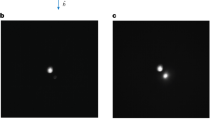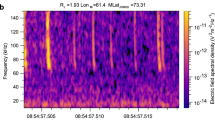Abstract
Since its discovery in 1955, Jupiter decametric emission has been extensively studied with ground-based instruments1, and more recently by planetary radioastronomy experiment on board the Voyager spacecraft2,3. However, we are still far from understanding the origin of the emission, mainly because we have no direct information about the position and structure of the source, due to the low spatial resolution of instruments at those wavelengths. Previous theories have assumed that the source emission takes place along magnetic field lines, close to the local gyrofrequency. We propose here a method to test this hypothesis by studying interplanetary scintillations which modulate the emission when received on Earth, and quantify the predicted effects. Preliminary results indicate that the emission is probably spatially distributed and could occur along field lines, and that Io controlled A and B sources are on opposite sides of Jupiter.
This is a preview of subscription content, access via your institution
Access options
Subscribe to this journal
Receive 51 print issues and online access
$199.00 per year
only $3.90 per issue
Buy this article
- Purchase on Springer Link
- Instant access to full article PDF
Prices may be subject to local taxes which are calculated during checkout
Similar content being viewed by others
References
Carr, T. D. & Desch, M. D. in Jupiter (ed. Gehrels, T.) 693 (University of Arizona Press, 1976).
Warwick, J. W. et al. Science 204, 995 (1979).
Warwick, J. W. et al. Science 206, 991 (1979).
Douglas, J. N. & Smith, H. J. Astrophys. J. 148, 885 (1967).
Slee, O. B. & Higgins, C. S. Aust. J. Phys. 21, 341 (1968).
Genova, F. & Leblanc, Y. Astr. Astrophys. 98, 133 (1981).
Mitchell, D. G. & Roelof, E. C. J. geophys. Res. 81, 5071 (1976).
Acunã, M. H. & Ness, N. F. in Jupiter (ed. Gehrels, T.) 830 (University of Arizona Press, 1976).
Smith, E. J., Davis, L. Jr & Jones, D. E. in Jupiter (ed. Gehrels, T.) 788 (University of Arizona Press, 1976).
Boischot, A. et al. Icarus 43, 399 (1980).
Author information
Authors and Affiliations
Rights and permissions
About this article
Cite this article
Genova, F., Boischot, A. Structure of the source of jovian decametric emission and interplanetary scintillation. Nature 293, 382–383 (1981). https://doi.org/10.1038/293382a0
Received:
Accepted:
Issue Date:
DOI: https://doi.org/10.1038/293382a0
This article is cited by
-
The Lunar Radar Sounder (LRS) Onboard the KAGUYA (SELENE) Spacecraft
Space Science Reviews (2010)
-
Bursts of type N in Jupiter's decametric radio spectra
Earth, Moon and Planets (1985)
Comments
By submitting a comment you agree to abide by our Terms and Community Guidelines. If you find something abusive or that does not comply with our terms or guidelines please flag it as inappropriate.



